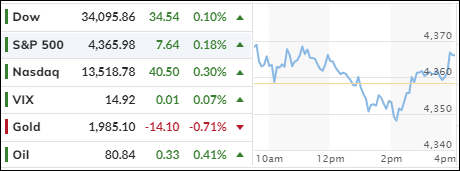
- Moving the markets
The S&P 500 wandered around like a lost sheep on Monday, as Wall Street tried to keep up the good vibes from last week’s stellar performance. In the end, after a tiny surge, nothing much changed.
Just to refresh your memory, all the major indexes had their best week of the year, starting November with a bang. The Dow soared by 5.1% last week, its biggest jump since October 2022. The S&P climbed 5.9% in the same period, and the Nasdaq rocketed 6.6%.
It was the best week for both indexes since November 2022. Weak jobs data also pushed bond yields lower, which helped stocks.
As I wrote before, this was just a nice bounce back from a bear market, and it only erased the losses that the buy-and-hold folks suffered since 9/22/23, when we issued our last domestic “Sell” signal.
The big question is whether this bounce can turn into a new bull market, as earnings season is almost over. JP Morgan thinks this rally will fizzle out soon:
We think that stocks will go back to being a bad deal as the Fed is going to keep rates high for longer, stocks are overpriced, earnings forecasts are too rosy, companies are losing their edge, profit margins are shrinking, and sales growth is slowing down.
I agree, this rally could collapse like a house of cards. But we don’t need to speculate, we will just follow the direction of our Trend Tracking Indexes.
A lot depends on what Fed chair Powell says in the next few days. He is scheduled to speak twice, and traders will be listening closely to see if he is more hawkish or dovish.
Most shorted stocks got hammered today, as there was no sign of a short squeeze. Regional banks gave up half of Friday’s gains, Bond yields went up with the 10-year undoing Friday’s drop.
The dollar stayed the same, gold slipped lower and fell below $2k. Financial conditions have eased, and we’ll see how Fed head Powell reacts, after he was happy that they had tightened.
Will he talk them up again on Thursday? Or will he change his tune and sing a different song?
2. “Buy” Cycle (12/1/22 to 9/21/2023)
The current Domestic Buy cycle began on December 1, 2022, and concluded on September 21, 2023, at which time we liquidated our holdings in “broadly diversified domestic ETFs and mutual funds”.
Our International TTI has now dipped firmly below its long-term trend line, thereby signaling the end of its current Buy cycle effective 10/3/23.
We have kept some selected sector funds. To make informed investment decisions based on your risk tolerance, you can refer to my Thursday StatSheet and Saturday’s “ETFs on the Cutline” report.
Considering the current turbulent times, it is prudent for conservative investors to remain in money market funds—not bond funds—on the sidelines.
3. Trend Tracking Indexes (TTIs)
The markets did not show much direction during the session, but they rose slightly at the end and finished higher. The activity was not widespread, so our Domestic TTI decreased a little, but the international one increased slightly.
However, that change does not clearly break the trend line, which means we are still bearish for now.
This is how we closed 11/06/2023:
Domestic TTI: -2.44% below its M/A (prior close -1.93%)—Sell signal effective 9/22/2023.
International TTI: +0.11% above its M/A (prior close +0.03%)—Sell signal effective 10/3/2023.
All linked charts above are courtesy of Bloomberg via ZeroHedge.
Contact Ulli